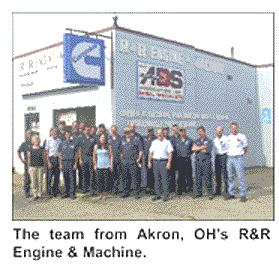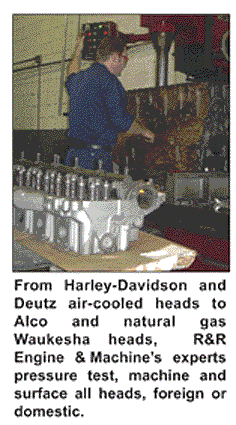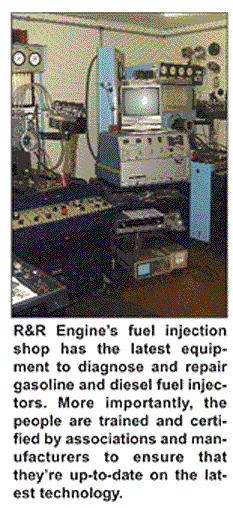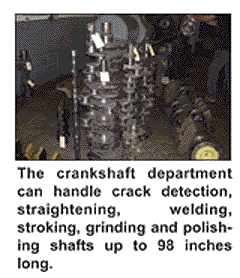
Turning 40 used to be a bad thing… On that tragic day, the black balloons, the wacky "Over The Hill" gag gifts and the general air of sympathy that your best years had all come and gone were about the only things you could hope for.
That is, if you view 40 as old. But with a positive outlook and a refusal to stand still, 40 isn’t the end of the good times – it’s the best of times.
R&R Engine and Machine in Akron, OH, is testament to that philosophy. Celebrating its 40th business anniversary this year, the 2006 Engine Builder Machine Shop of The Year has grown tremendously over the years and doesn’t show signs of slowing down. According to vice president Bryan Menke, the secret to success isn’t necessarily doing things differently – it’s doing the right things and doing them well.
"Our industry is in the midst of a busy time," says Menke. "Customers continue to repair and update older engines of all sizes and makes, as well as asking for minor and major repairs to newer electronic engines. Within our four departments, we continue to see an annual increase of 5-8 percent in sales, especially in our drive-in and electronic fuel injection departments."
Shop Profile
R&R Engine and Machine was founded with three employees in 1967 as R&R Tool and Machine, and manufactured and machined specialized tooling for the automotive industry in a single 2,000 sq. ft. building. In 1978 the company added a fuel injection repair shop and a four-bay garage, putting a parts department, truck shop, machine shop and fuel shop under one roof.

Over the succeeding years, the business outgrew its existing wall space several times. That original 2,000 sq. ft. building has been expanded to over 22,000 sq. ft. and includes drive-in service bays and and an engine dyno room. Current construction projects are now adding an additional 7,800 sq. ft. to the service bays and another 900 sq. ft. to the parts department.
Today, R&R Engine sells, repairs and rebuilds engines ranging from two-stroke Kohlers to 16-cylinder Caterpillars. The company is an authorized engine dealer for 19 different manufacturers and is an authorized Cummins dealer.
Menke explains the company is split into four parts. The parts department consists of the front counter to handle walk-in customers and the back parts center to fulfill parts requisitions for the company’s other three departments.
The machine shop consists of six different work centers: crankshaft, block, cylinder head, rods, general machining and welding. The crank department can handle magnetic particle inspection, straightening, welding, stroking, polishing and grinding shafts up to 98" long.

"This department’s specialty is stroking John Deere, Minneapolis-Moline, Allis-Chalmers and other race or pulling tractor cranks," says Menke. "That’s a market you don’t just rush into: you can’t just jump into it. The customers we service are knowledgeable about their class and the rules and what specs to build to."
The block department is capable of boring and honing from 1.5"- to 21" diameter bores, as well as align boring, align honing decking. "From Cushman jugs to counterboring and decking 399 Caterpillar blocks, this workstation can perform about any machining operation to a block," Menke says.
"The cylinder head department reconditions all heads from Harley-Davidson and Deutz air-cooled heads to Alco and natural gas Waukesha heads," says Menke. "All heads – foreign or domestic – are pressure tested and machined using the latest equipment available. Surfacing is done on a CBN, PCD or standard stone grinding machine."
The rod department is capable of checking, polishing and reconditioning most all types of connecting rods. This department also reconditions light and heavy-duty spindles by rebushing and pin fitting.
With a lathe, two Bridgeports, Sunnen balancer and an EDM machine for special operations, the general machining department handles such diverse tasks as flycutting pistons, boring and rebushing axles, burning or machining out broken bolts or taps, repairing block head bolt holes, boring and bushing of flywheel pilot bearings, cam bearing bore repair and cam fitting on overhead cam engines such as the 3406E, 60 series and aluminum automotive heads.
R&R Engine’s welding department is skilled in arc, MIG and TIG welding repairs on steel or aluminum blocks, heads and components. "This department also helps our other departments by shrinking the hard-to-remove valve seats and liners for easy extraction," says Menke.

R&R Engine has an eight-bay service garage to diagnose and troubleshoot engine and driveability issues ranging from intermittent electrical problems to engine failure analysis. The seven-person staff can handle minor repair, in-chassis overhaul, out-of-chassis overhaul, generator repair and drive-out service. This department also builds the medium and heavy-duty engines which are then dyno-tested using its 1,000 hp Power Test dynamometer.
Menke says the company once considered eliminating its drive-in repair service but he recognized its potential. The department has grown ten-fold over the past few years and he says the future continues to look bright.
The company’s other department has also experienced phenomenal growth, Menke says.
"The fuel injection shop consists of four technicians who use the latest tooling and test equipment to test and repair diesel and gasoline fuel injectors, superchargers, blowers, diesel fuel injection pumps and governors, air compressors, accessory drives, cam followers, rocker boxes and turbochargers. This department represents OEM manufacturers like Ambac, Robert Bosch, Delphi, Stanadyne, Zexel, Alliant Power, Denso, Garrett, Schwitzer/ Borg Warner and Holset. In addition, this department stocks a large inventory of parts and exchange units to minimize customer downtime.
The Keys To Success
Attention to the needs of the customer has been a key to the company’s success, says Menke. At a time when other shops might consider cutting back, Akron’s Machine Shop of the Year continues to grow.
"I think our shop is a cut above average due to two major attributes," Menke says. "First is the commitment of our employees. Of the 30 employees, the average tenure is 17 years. Many of our employees have been with us 26 years or more. Without their expertise, dedication and commitment to giving each customer the best possible service, our company’s customer base and reputation would be jeopardized."
Secondly, says Menke, while you might not be able to buy success, you still have to pay for it.
"Our company is constantly replacing or updating machinery and tooling throughout the shop. To become better than the average shop, we feel the company must invest not only in new tooling for the latest engine machining, but also in all computer diagnostic equipment for our drive-in and drive-out service."
Obviously, since there’s no guarantee of success, keeping a grip of all aspects of his job is crucial. Being flexible is key.
With a degree in industrial management, Menke says his skills are tested almost daily. He told the Akron Beacon Journal "I’ve made some quick decisions (about employees) and later realized if I did something differently – sent him for schooling or got him more involved with the company, maybe he would have turned out better.
"Today’s business is very different. Competition is different. Workers are different. Young people you hire are very different than 20 years ago. So management is a constant learning thing for me. A day doesn’t go by that I don’t learn something," Menke explains.
"The key to ensuring that our shop survives and prospers during the next two to five years will lie within the management of the company," Menke acknowledges.
"Times are changing and a better grip upon managing all aspects of the business is needed."
He points to five points that he feels are critical to survival.
You should have frequent time and profit evaluations of each job function to ensure job efficiency and proper profit is earned.
Be vigilant that salesmen solicit all possible work from present customers and distribute information to future customers about the company and what services we can offer.
Have an aggressive advertising and marketing campaign through magazine or newspaper ads, including monthly promotional flyers.
Take advantage of all engine and industry-related schools and seminars in order to have the latest information, training and service bulletins.
Treat your employees and customers the way you would want to be treated to ensure many years of working together in the future.
"Customers continue to want their original work machined and repaired," Menke says. "Custom machining, balancing and assembling continues to grow for engines in the truck and tractor pullers, drag and stock car racers, small and heavy duty diesels and import race engines. The future of the custom rebuilding service remains bright as long as you stay focused on being the best you can be with up-to-date technology, training and customer service."













